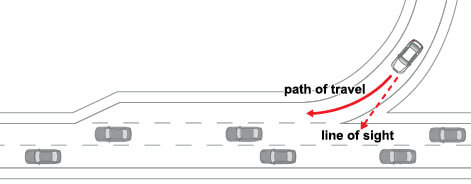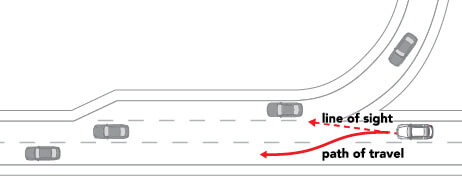12- Freeway Driving
Freeway driving – part one
Goal: Teach your teen freeway basics and how to safely enter and exit a freeway.
Location: Start on a multi-lane freeway with easily accessible exits, at a time when traffic is light, such as a weekend morning. Move on to practice at heavier traffic times when your teen is ready.
Lesson one – observation
Before your teen gets behind the wheel on the freeway, have your teen spend some time on freeways with you as the driver and your teen as the passenger. Emphasize the importance of looking ahead to anticipate potential problems, and explain key freeway features, such as:
- The different kinds of interchanges
- The meanings of freeway signs and signals
- The meanings of different lane lines and markings
Lesson two – on-ramp segments
Explain the three segments of on-ramps, and how they’re used:
- Entrance area: This stretch allows the driver time to search the freeway and evaluate how much space they have to enter and what speed is needed.
- Acceleration area: The driver brings the vehicle up to the speed of freeway traffic flow.
- Merge area: The driver uses this space to merge into the traffic flow.
Lesson three – merging

There is plenty of time to merge. If a gap doesn’t present itself immediately, adjust your speed as early as possible in order to find one.
Teach the steps for merging onto a freeway:
- Check for on-ramp speed signs.
- Before the entrance area, make quick glances at the freeway, scanning for vehicles and entry gaps.
- In the acceleration area, signal to show intent to enter the freeway and adjust speed to match the traffic flow.
- In the merge area, enter the flow of traffic, checking mirrors and blind spots.
- Turn off the turn signal and begin looking ahead to anticipate problems or upcoming lane changes.
- Do not completely stop in the entrance area unless absolutely necessary.
Lesson four – exiting
Teach the steps for exiting a freeway:
- Identify the exit well ahead of time.
- Scan traffic for problems when approaching the exit, but don’t slow down on the freeway.
- Start to signal four to six seconds before reaching the ramp.
- Upon entering the ramp, tap the brakes and begin to slow down to the posted exit ramp speed limit before reaching the curve. On some ramps, be prepared to rapidly reduce your speed.
- Practice both merging and exiting 10-12 times each, or more if needed, for your teen to feel comfortable.
Worthy of repetition
Freeway driving – part two
Goal: Teach your teen to maneuver safely in complex freeway driving environments at higher speeds.
Location: Start on a multi-lane freeway with easily-accessible exits, at a time when traffic is light, such as a weekend morning. Move on to practice at heavier traffic times when your teen is ready.
Lesson one – steering technique
Once on the freeway, coach your teen on steering technique. At fast freeway speeds, excessive steering can be dangerous and lead to loss of control. Remind your teen to steer gently on freeways.
Lesson two – lane changing

For the first several lane changes you may need to talk your teen through the decision-making process. Double-check all mirrors to make sure that the lane is clear.
In the high-speed, complex freeway environment, lane-changing skills are very important. Have your teen spend lots of time practicing the lane-changing and passing skills previously learned in “Skill Nine: multi-lane roads”,” until they are comfortable performing them at freeway speeds. Remind your teen to:
- Watch for merging vehicles and move one lane left to make space for them when needed.
- Change lanes one at a time only.
- Watch mirrors for tailgaters and move to another lane to let them pass. Grow comfortable with checking blind spots frequently to be aware of the traffic around you.
Lesson three – three-second rule
Review the three-second rule for following distance, learned in “Skill Six: looking ahead.” At higher speeds it’s recommended to add more following distance. Additionally, coach your teen to use a three-second rule for these freeway driving circumstances:
- Merging onto a freeway
- Changing lanes
- Exiting a freeway
Lesson four – challenging road conditions
Coach your teen to adjust travel speed and vehicle position based on weather and road conditions. Once your teen is comfortable with and proficient at freeway driving in good conditions, spend some practice time on freeways under more challenging conditions, such as rain. Coach them to always use appropriate caution, as conditions can change quickly.
Lesson five – road trips
Consider planning some short day trips with your teen to a destination two to three hours away. Have them drive there and back. Find an event or place that you will both enjoy and have fun.